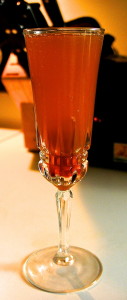by Bob Benenson, FamilyFarmed
New Year’s Eve approaches, and the mind turns to bubbly wine. And New Year’s resolutions. And I can tell you from experience that few things stimulate creative thinking about those resolutions better than a sparkling wine cocktail spiked with potent spirits.
Now many people may think of “champagne cocktail” as synonymous with “mimosa,” the sparkling wine-orange juice combo consumed by the gallon at thousands of restaurant brunches. Nothing against mimosas, but if you desire a little variety — with a local Good Food angle to boot — we’re at your service.
Some time ago, I discovered the champagne cocktail of my dreams: the Seelbach. The shot of bourbon that provides this epic drink with its backbone also betrays its origins at a Louisville, Kentucky, hotel of the same name.
But after I moved to Chicago and became more fully engaged with the local food (and drink) movement, I undertook some experiments, using spirits produced in the region to give them a little more taste of home.
I call one of these concoctions the Chicago Hum-dinger. The Oat Whiskey made by Koval — which in 2008 became the first (legally) functioning distillery in Chicago since pre-Prohibition — substitutes for the Kentucky bourbon in the original Seelbach. Instead of triple sec, this drink includes Hum, a botanical liqueur co-invented by Chicago mixologist Adam Seger, that gives the drink a pretty reddish color. Orange bitters stand in for the Angostura and Peychaud’s bitters in the original drink.
The second, with a slightly lighter touch on the alcohol, dubbed the Michigan Dutch Apple Barrel. This reach across Lake Michigan includes the Beer Barrel Bourbon by New Holland, the craft brewery and distillery in Holland, Mich., mixed with Michigan apple cider and cherry-thyme syrup by Chicago’s Jo Snow company, and the sparkling wine, of course.
Note that how much whiskey and liqueur you use should be dictated by the size of the glass you are using. The following proportions are based on a tall champagne flute. If you are using a smaller glass, you’ll want to reduce the 1:1 dimension of whiskey and liqueur a bit (or there won’t be much room left for champagne).
This is just a starter, as the potential combinations are practically endless. If you have any of your own recipes to share, please use the Comments section on this article.
And we’re spending a quiet New Year’s Eve at home, so… there might be a sequel!
The recipes follow:
The Seelbach*
1-1/2 oz. bourbon
1-1/2 oz. Cointreau orange liqueur
7 dashes Angostura bitters
7 dashes Peychaud’s bitters
4 oz. chilled brut champagne
Add ingredients, in the order listed, to a champagne flute. An orange twist may be used as a garnish.
* From ‘The Kentucky Bourbon Cocktail Book” by Joy Perrine and Susan Reigler
Chicago Hum-dinger
1-1/2 oz. Koval Dark Oat whiskey
1-1/2 oz. Hum botanical liqueur
14 drops of orange bitters (such as Fee Brothers)
top with sparkling wine
Layer ingredients in a champagne flute.
Michigan Dutch Apple Barrel
1-1/2 oz. New Holland Beer Barrel Bourbon
1-1/2 oz. apple cider
14 drops of Jo Snow cherry-thyme syrup (or other fruit syrup)
top with sparkling wine
Layer ingredients in a champagne flute. Maraschino cherries make a nice garnish.




Some nice concoctions from Mr. Benenson. Thanks for spending all that time in the lab.